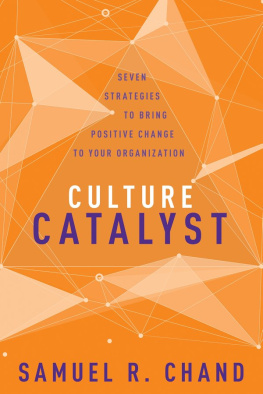Chand - CultureCatalyst
Here you can read online Chand - CultureCatalyst full text of the book (entire story) in english for free. Download pdf and epub, get meaning, cover and reviews about this ebook. year: 2018, publisher: Whitaker House, genre: Business. Description of the work, (preface) as well as reviews are available. Best literature library LitArk.com created for fans of good reading and offers a wide selection of genres:
Romance novel
Science fiction
Adventure
Detective
Science
History
Home and family
Prose
Art
Politics
Computer
Non-fiction
Religion
Business
Children
Humor
Choose a favorite category and find really read worthwhile books. Enjoy immersion in the world of imagination, feel the emotions of the characters or learn something new for yourself, make an fascinating discovery.
CultureCatalyst: summary, description and annotation
We offer to read an annotation, description, summary or preface (depends on what the author of the book "CultureCatalyst" wrote himself). If you haven't found the necessary information about the book — write in the comments, we will try to find it.
CultureCatalyst — read online for free the complete book (whole text) full work
Below is the text of the book, divided by pages. System saving the place of the last page read, allows you to conveniently read the book "CultureCatalyst" online for free, without having to search again every time where you left off. Put a bookmark, and you can go to the page where you finished reading at any time.
Font size:
Interval:
Bookmark:



Scripture quotations taken from the Holy Bible, New International Version , NIV, 1973, 1978, 1984 by the International Bible Society. Used by permission of Zondervan. All rights reserved.
Culture Catalyst:
Seven Strategies to Bring Positive Change to Your Organization
(Previously published as Cracking Your Churchs Culture:
Seven Keys to Unleashing Vision and Inspiration )
www.SamChand.com
ISBN: 978-1-64123-078-0
eBook ISBN: 978-1-64123-079-7
2011, 2018 by Dr. Samuel R. Chand
Whitaker House
1030 Hunt Valley Circle
New Kensington, PA 15068
www.whitakerhouse.com
Library of Congress Cataloging-in-Publication Data (Pending)
No part of this book may be reproduced or transmitted in any form or by any means, electronic or mechanicalincluding photocopying, recording, or by any information storage and retrieval systemwithout permission in writing from the publisher. Please direct your inquiries to permissionseditor@whitakerhouse.com.
This book has been digitally produced in a standard specification specification in order to ensure its availability.
I acknowledge the thousands of senior leaders who have allowed me to learn from them and their organizations. This book is possible because of their honesty and vulnerability. The contents of this book are a collage of the personal pain and frustration leaders face as they create healthy cultures to fulll their visions. I also want to thank my friend Pat Springle for working with me to shape the contents of this book.
To my wife, Brenda; my daughters, Rachel and Deborah;
and my granddaughter, Adeline Joy they all give up so much to make my dreams a reality. Because of them, I never lack for constant and consistent encouragement.
Unless commitment is made,
there are only promises and hopesbut no plans.
Peter Drucker
A church in the Midwest grew rapidly, but the growth curve gradually flattened. In recent years, they saw almost no growth at all. In the early days of explosive growth, the senior pastor taught seminars and spoke at national conferences to instruct other pastors in how to grow their churches, but in the past few years, he received very few invitations to speak. When the curve began to flatten, he took his senior staff to hear noted speakers. Surely, he thought, they could learn something new and overcome stagnation. When that didnt fix things, they hired consultants to analyze the situation and prescribe a solution. When this strategy didnt effect the change they wanted, the senior pastor began cleaning house. He hired and fired so many people that the offices needed revolving doors. Still, the church didnt grow.
Out of frustration, the pastor left the church. He moved his family a few miles away and started another church with about two hundred people who followed him there. Some would call this a church plant; I think it was a glorified church split.
At the original church, a new pastor came into the office full of fresh ideas and a clear vision of where the church could go; thats exactly why he was selected. After a long, grueling first eighteen months with the new pastor on the job, however, the churchs growth curve had barely budged. When he called me, he was frustrated and tired. In our first meeting, he told me sadly, I dont understand. We spent time and money to reenergize the congregation. We took our top staff on a retreat to instill the new vision into them. We hired more staff, and we reformatted our worship experience. We started plenty of new programs. We redesigned our stage set. We created a killer Web site, reconfigured our offices, redecorated to create a fresh ambiance, and designed a new logo for the church. We even wrote a song about how great we are! But none of this has made a bit of difference. We havent gone backward, and Im glad of that, but I thought wed be way ahead of where we are today. He paused for a second and then asked, What am I missing?
This senior pastor had done a lot of good things, but he failed to understand the impact of the existing organizational culture on his new, exciting vision for the church. It was like changing the engine on a sports car to make it faster, but it was spinning its wheels in the mud. Or to use a different metaphor, he tried to transplant a heart into a patient whose body rejected the foreign organ. No matter how perfect the new heart was, the patient had no chance at all unless the body accepted it.
Culturenot vision or strategyis the most powerful factor in any organization. It determines the receptivity of staff and volunteers to new ideas, unleashes or dampens creativity, builds or erodes enthusiasm, and creates a sense of pride or deep discouragement about working or being involved there. Ultimately, the culture of an organizationparticularly in churches and nonprofit organizations, but also in any organizationshapes individual morale, teamwork, effectiveness, and outcomes. In an article in the magazine Executive Leadership , Dick Clark explains how he took the pharmaceutical firm Merck to a higher level: The fact is, culture eats strategy for lunch. You can have a good strategy in place, but if you dont have the culture and the enabling systems, the [negative] culture of the organization will defeat the strategy.
To help you uncover the nature of your existing culture and identify the steps of change, this book examines the full range of cultural health, from inspiring to toxic, and describes the seven keys of CULTURE:
C ontrol
U nderstanding
L eadership
T rust
U nafraid
R esponsive
E xecution
Insight is the first and crucial step toward change.
Looking at the Landscape
In the past decade or so, dozens of books and countless articles have been written about the importance of corporate culture, but relatively few churches and nonprofit organizations have taken the arduous (but necessary) steps to assess, correct, and change their culture. First, we need to understand what we mean by the term organizational culture . It is the personality of the church or nonprofit. Like all personalities, its not simple to define and describe. Organization development consultant, speaker, writer, and filmmaker Ellen Wallach observes, Organizational culture is like pornography; it is hard to define, but you know it when you see it.
Organizational culture includes tangibles and intangibles. The things we can see are the way people dress and behave, the look of the corporate offices, and the messages of posters on the walls. The intangibles may be harder to grasp, but they give a better read on the organizations true personality. The organizations values (stated and unstated), beliefs, and assumptions; what and how success is celebrated; how problems are addressed; the manifestations of trust and respect at all levels of the organization these are the intangible elements of culture. Every group in society family, town, state, nation, company, church, civic group, team, and any other gathering of people has a culture, sometimes clearly identified but often camouflaged.
Many leaders confuse culture with vision and strategy, but they are very different. Vision and strategy usually focus on products, services, and outcomes, but culture is about the people the most valuable asset in the organization. The way people are treated, the way they treat their peers, and their response to their leaders is the air people breathe. If that air is clean and healthy, people thrive and the organization succeeds, but to the extent that it is toxic, energy subsides, creativity lags, conflicts multiply, and production declines. Im not suggesting that churches and nonprofits drop their goals and spend their time holding hands and saying sweet things to each other. That would be a different kind of toxic environment! A strong, vibrant culture stimulates people to be and do their very best and reach the highest goals. Spiritual leaders point the way forward, but they invite meaningful participation from every person at all levels of the organization. Together, they work hard toward their common purpose, and they celebrate each others accomplishments every step along the way. Trust is the glue that holds the organization together and gives it the strength it needs to excel.
Font size:
Interval:
Bookmark:
Similar books «CultureCatalyst»
Look at similar books to CultureCatalyst. We have selected literature similar in name and meaning in the hope of providing readers with more options to find new, interesting, not yet read works.
Discussion, reviews of the book CultureCatalyst and just readers' own opinions. Leave your comments, write what you think about the work, its meaning or the main characters. Specify what exactly you liked and what you didn't like, and why you think so.











